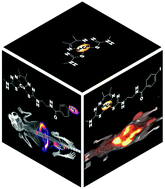A dual radiolabelling approach for tracking metal complexes: investigating the speciation of copper bis(thiosemicarbazonates) in vitro and in vivo†
Abstract
Copper(II)bis(thiosemicarbazonato) complexes such as [64Cu]Cu-ATSM continue to be investigated for positron emission tomography (PET) imaging of tumour hypoxia. However, the currently proposed mechanisms for the mode of action of these complexes are unable to account fully for their observed biological behaviour. In order to examine the roles of the copper metal and the ligand, we designed a pair of 123I/64Cu-copper bis(thiosemicarbazonates), radiolabelled at either the metal or at the ligand. In vitro cellular retention studies of the orthogonal pair demonstrate for the first time that retention under hypoxia involves dissociation of the copper bis(thiosemicarbazone) complex, consistent with the previously suggested mechanism of reductive trapping of copper. In contrast, in vivo biodistribution and dynamic PET/SPECT imaging of the orthogonally labelled complexes underline our previous findings for [64Cu]Cu-ATSM and [64Cu]Cu-acetate, providing further support for the important contribution of copper metabolism in the in vivo hypoxia selectivity of Cu-ATSM. This dual radiolabelling approach may find applications for determining the speciation of other metal complexes in vitro and in vivo.

- This article is part of the themed collection: Celebrating the 2016 RSC Prize and Award Winners

 Please wait while we load your content...
Please wait while we load your content...